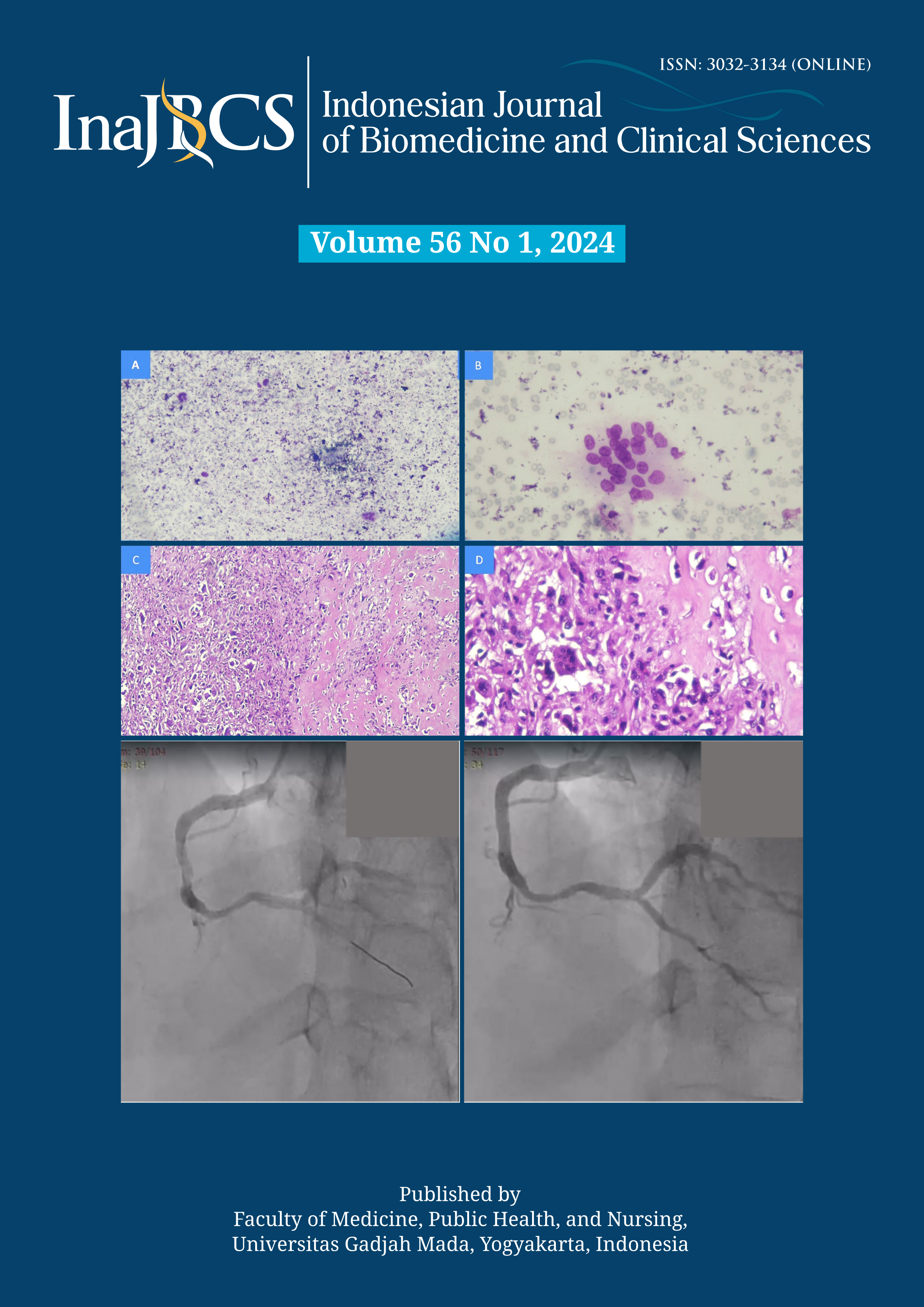Impact of multivessel coronary artery disease on early and late clinical outcome in ST-Segment elevation myocardial infarction patients who underwent percutaneous coronary intervention: insight from Indonesia
Abstract
It is estimated that 15 people for every 1000 Indonesian residents suffer from cardiovascular disease (CVD) including ST-segment elevation myocardial infarction (STEMI). Percutaneous coronary intervention (PCI) is often performed in patients with STEMI. Several factors affect clinical outcome after PCI procedure including multivessel coronary artery disease. This study aimed to measure the impact of multivessel coronary artery disease on the early and late outcomes of STEMI patients undergoing PCI procedures. This was a prospective cohort study on STEMI patients undergoing PCI procedures from the period of August to December 2021. Two expected cohorts were performed i.e. patients who suffered from single-vessel disease (SVD) and patients who suffered from multivessel disease (MVD). Forty six patients with STEMI were enrolled in this study consisting of 24 (52.17%) patients with MVD and 22 (47.83%) patients with SVD. No significant difference in baseline characteristics between MVD and SVD groups was observed (p > 0.05). The MVD group (91.67%) used a more radial percutaneous approach compared with the SVD group (54.55%; p = 0.04). In addition, no significant difference between the SVD group and the MVD group in major adverse cardiovascular events (MACE) and echocardiographic outcome after 90-d follow up was observed (p > 0.05). In conclusion, MVD has similar impacts on early and late clinical outcomes compared with SVD in STEMI patients undergoing PCI procedures.
References
World Health Organization. The atlas of heart disease and stroke/Judith Mackay and George Mensah; with Shanthi Mendis and Kurt Greenland. Geneva PP-Geneva: World Health Organization; 2004.
Balai Penelitian dan Pengembangan Kesehatan (Balitbangkes). Hasil utama riset kesehatan dasar (Riskesdas). Jakarta: Balitbangkes, Kementerian Republik Indonesia; 2018.
Firman D. Tinjauan pustaka intervensi koroner perkutan primer. J Kardiol Indones. 2010 May-Aug; 31: 112–117.
Lambert L, Brown K, Segal E, Rodes-Cabau J, Bogati, P. Association between timeliness of reperfusion therapy and clinical outcomes in ST-elevation myocardial infarction. JAMA. 2010; 303: 2148-2155.
https://doi.org/10.1001/jama.2010.712
Terkelsen CJ, Sørensen, JT, Maeng, M, Jensen LO, Tilsted HH, et al. System delay and mortality among patients with STEMI treated with primary percutaneous coronary intervention. JAMA 2010; 304:763-71.
https://doi.org/10.1001/jama.2010.1139
Vora AN, Holmes DN, Rokos I, Roe MT, Granger CB, et al. Fibrinolysis use among patients requiring interhospital transfer for ST-segment elevation myocardial infarction care: a report from the US National Cardiovascular Data Registry. JAMA Intern Med 2015; 175:207-15.
https://doi.org/10.1001/jamainternmed.2014.6573
O’Gara PT, Kushner FG, Ascheim DD, CaseyJr DE, Chung MK, de Lemos JA, et al. ACCF/AHA guideline for the management of ST-elevation myocardial infarction: a report of the American College of Cardiology Foundation/American Heart Association Task Force on Practice Guidelines. J Am Coll Cardiol 2013; 61(4):e78-140.
https://doi.org/10.1016/j.jacc.2012.11.019
Morrow DA. Myocardial infarction: a companion to Braunwald’s heart disease. Amsterdam: Elsevier; 2017.
Thygesen K, Alpert JS, Jaffe AS, Chaitman BR, Bax JJ, et al. Fourth universal definition of myocardial infarction. Eur Heart J 2018; 40: 237-69.
https://doi: 10.1093/eurheartj/ehy462
Plitt A, Claessen BE, Sartori S, Baber U, Chandrasekhar J, Aquino M, et al. Impact of stent diameter on outcomes following percutaneous coronary intervention with second‐generation drug‐eluting stents: Results from a large single‐center registry. Catheter Cardiovasc Interv 2019; 96(3):558-64.
https://doi.org/10.1002/ccd.28488
Chiarito M, Cao D, Nicolas J, Roumeliotis A, Power D, Chandiramani R, et al. Radial versus femoral access for coronary interventions: An updated systematic review and meta-analysis of randomized trials. Catheter Cardiovasc Interv 2021; 97:1387-1396.
https://doi.org/10.1002/ccd.29486
Ng AK, Ng YP, Ip A, Jim MH, Siu CW. Association between radial versus femoral access for percutaneous coronary intervention and long‐term mortality. J Am Heart Assoc 2021; 10(15):e021256.
https://doi.org/10.1161/jaha.121.021256.
Anello A, Moscoso I, Tófano RJ, Salman AA, Cristóvão SAB, et al. Comparison of immediate results and follow-up of patients with single-vessel and multivessel coronary artery disease younger than 50 years of age undergoing coronary stent implantation. Arq Bras Cardiol 2003; 81(5):494-505.
https://doi.org/10.1590/s0066-782x2003001300006
Park J, Choi KH, Lee JM, Kim HK, Hwang D, Rhee TM, et al. Prognostic implications of door‐to‐balloon time and onset‐to‐door time on mortality in patients with ST‐segment–elevation myocardial infarction treated with primary percutaneous coronary intervention. J Am Heart Assoc 2019; 8(9):e012188.
https://doi.org/10.1161/JAHA.119.012188
Anjum I, Khan MA, Aadil M, Faraz A, Farooqui M, et al. Transradial vs transfemoral approach in cardiac catheterization: a literature review. Cureus 2017; 9(6):e1309.
https://doi.org/10.7759/cureus.1309
Bolognese L, Neskovic AN, Parodi G, Cerisano G, Buonamici P, et al. Left ventricular remodeling after primary coronary angioplasty: patterns of left ventricular dilation and long-term prognostic implications. Circulation 2002; 106(18):2351-7.
https://doi.org/10.1161/01.cir.0000036014.90197.fa
Goldstein JA., Demetriou D, Grines CL, Pica M, Shoukfeh M, et al. Multiple complex coronary plaques in patients with acute myocardial infarction. N Engl J Med 2000; 343(13):915-22.
https://doi.org/10.1056/NEJM200009283431303
Henderson M, Carberry J, Berry C. Targeting an Ischemic Time <120 Minutes in ST-Segment-Elevation Myocardial Infarction. J Am Heart Assoc 2019; 8:e013067.
https://doi.org/10.1161/JAHA.119.013067
Keeley EC, Boura JA., Grines CL. Primary angioplasty versus intravenous thrombolytic therapy for acute myocardial infarction: a quantitative review of 23 randomised trials. Lancet 2003; 361(9351):13-20.
https://doi.org/10.1016/S0140-6736(03)12113-7
Tarantini G, Cacciavillani L, Corbetti F, Ramondo A, Marra MP, et al. Duration of ischemia is a major determinant of transmurality and severe microvascular obstruction after primary angioplasty: a study performed with contrast-enhanced magnetic resonance. J Am Coll Cardiol 2005; 46(7):1229-35.
https://doi.org/10.1016/j.jacc.2005.06.054
Tarantini G, Napodano M, Gasparetto N, Favaretto E, Marra MP et al. Impact of multivessel coronary artery disease on early ischemic injury, late clinical outcome, and remodelling in patients with acute myocardial infarction treated by primary coronary angioplasty. Coron Artery Dis 2010; 21(2):78-86.
https://doi.org/10.1097/MCA.0b013e328335a074
Théroux P. Angiographic and clinical progression in unstable angina. Circulation 1995; 91:2295-8.






